
Last updated: 09/07/2010 01:15 AM
(C) Copyright 2010 Lawrence Chasin and Deborah Mowshowitz Department of Biological Sciences Columbia University New York, NY 10027
Bio C2005/F2401x ……..Sept 7., 2010…….. Lec.1 ……….. L. Chasin
Clickable pictures are from Purves, et. al., Life, 6th Edition or from Internet links. Links to answered questions posed by students in previous years are also provided: follow
Handouts - : Course description; exponential growth; functional groups, flow of glucose
Biol. C2005x/F2401x = Intro Bio ……. Larry Chasin ….. Deborah Mowshowitz: administrative items . . . . .
Outline
A biochemist's view
of biology
Understanding something in science means verifiable prediction.
Quantitative predictions are the most satisfying.
Hierarchy
among the sciences, one builds upon the others
Characteristics of living things:
Complex structure
Chemical interaction with the environment.
Exact reproduction of a complex interactive structure
Cells:
All living these are made up of cells, the basic
building
block in biology.
The simplest living things are made up of a single cell.
The simplest cell is a bacterial cell.
Study of the basic characteristics of life in simple bacterial cells has
facilitated understanding in biology.
What are cells
made of?
The atoms used to make a bacterial cell must be assimilated from the
environment.
E. coli can be made from glucose + salts.
All the carbon atoms in E. coli's 5000 types of molecules can be
derived from this one molecule (glucose).
Cell
reproduction:
How you get two cells from one is a central problem posed in this course.
How can you make one new cell from an existing cell?
To understand the question, we first must know just what molecules a cell is
made of.
The 5
categories of E. coli's molecules:
Polysaccharides
Lipids
Nucleic Acids
Proteins
Small molecules
Exponential
growth
But first, how do cells grow, in quantitative terms?
Binary fission leads to exponential growth.
Exponential growth is mathematically predictable.
The
molecules in an E. coli cell: (1) Water
Most abundant single molecule is water.
Almost all chemical reaction in biology take
place in an aqueous environment.
Water forms hydrogen bonds
-----------------------------------------------------------------------------------------------------------------------------
Please pick up the handouts. Look for handouts at each class.
This is Biology C2005 (F2401), Introductory biology ... it is an introduction and not a general biology course. It's the first semester of a 2 semester sequence C2005-C2006 (F2401-F2402), that is intended for biology majors, science majors, and premeds. The second semester C2006 (F2402) is an independent course that is run somewhat differently than C2005 (F2401).
We put a lot of effort into producing a very complete course description explaining the mechanics of this course. Between this class and the next class, read the course description on the Web site, and if you still have any questions ask them next time.
The course description is available on the course Home Page on the Web. Some information may change during the first few weeks, so the best source is the Web version, which is up to date. You can get there from the Columbia home page, going to the Dept. of Biol. Sciences, then to "Courses". The URL is:
http://www.columbia.edu/cu/biology/courses/c2005
I will mention some items (8) related to the running of this course, although all this information is in fact in the course description..
1. This course has a Web site that MUST be consulted to keep up with announcements and other important information. Those without computers of their own can use the many computers available at kiosks and computer labs around the campus. (e.g., Butler Library; 251 Engineering terrace;215 Intl. Affairs Bldg.; 200 & 300 Lerner Hall).
2. The problem book is essential and is sold at the Village Copier on Broadway near 112th St. and is there now. You should be working on Problem Set #1. In general, throughout the semester, do the problems on what we have covered in lecture: don't get ahead, or behind. The problems are the heart of this course; the importance of solving or trying to solve the problems cannot be overemphasized. The problems are the heart of this course; the importance of solving or trying to solve the problems cannot be overemphasized.
3. The lectures we prepare will be on the course Web site. We do not read our lectures and we will not routinely include answers to any questions posed in class on the Web version. Thus the live and Web versions are never identical, and we encourage you to come to class to hear and see the live lectures. The Web lectures can be read aloud in less than 30 minutes, the live lectures last 75 minutes. For some lectures PowerPoint graphics are used and are posted. These are not a substitute for the Web lectures; i.e. you need to consult both
4. For exams, you will be responsible only for the topics covered in lecture, at a depth indicated in the lectures and in the problems. Although the Web lectures are designed to mimic the live lectures, the two will not always coincide. In particular, if the Web lecture is not entirely covered in the live lecture (for example, if time runs out), you will still be responsible for the Web lecture (unless otherwise noted; and this situation is a rarity). Thus it is the Web lectures (and PowerPoints) that include all the material we want to cover.
5. You can also ask questions by email and we (Dr. Mowshowitz or I) will answer you. Dr. Mowshowitz will teach the second 60% of the course (introduce Deborah Mowshowitz). We try to give answers that are different from the lectures, or at least phrased differently. And you can look at most past emailed questions (the ones judged useful) asked by your classmates and questions asked in previous years. We have established a searchable database of 1000 questions and answers on the course content. This is a tremendous resource for helping you understand points you find difficult.
6. C2005 students: Sign up for recitation sections using the form on the Web site. Look for your assignment to a section on the course Web page Friday or Saturday or Monday. Recitations will begin on Monday afternoon for some of you. If you have not been assigned to a recitation section by next week, go to any section the first week. There will be no quiz at the first recitation section, but there will be weekly quizzes thereafter.
7. Evening lectures (in Biology F2401) are the same as the morning lectures (in Biology C2005). Hear it either time or, for the insatiable, hear it twice.
8. Please note the date and time of the final examination on the web site lecture schedule. Make your travel plans accordingly.
9. We have attempted to make the running of
this course, including the exams and the grading as transparent as possible.
________________________________________________________________
|
1) Repeat what you have heard exactly as it was presented, know all
the terms and the definitions we or the texts have provided
|
Probably fail
|
|
2) Repeat what you have heard in your own words, showing you have
some understanding of the concepts and not just the words
|
Probably pass with up to a B-
|
|
3) Apply what you have learned to a new situation you have never
seen before thus proving that you have understood the concept and
not just learned how to describe it.
|
B to A
|
|
4) Synthesize a new application yourself or extend what you have
learned to a new situation of your own design
|
A
|
A biochemist's
view of biology
Biology is the study of living things, an attempt to understand how living
things work. The study of Life itself. What could be more important or
more interesting?
Understand... is a word that means different things to different people.
Understanding something
in science means verifiable prediction.
Quantitative predictions
are the most satisfying.
Let me tell you in a general way
what I mean when I feel I understand something in biology. I think for me it has
to do with the predictability of mathematics. I feel I understand how 2 + 2 = 4,
today and every time I try it. That prediction has been tested many times, and
it always comes out the same. When I see the laws of nature expressed as
predictable, mathematical, relationships, I get that same feeling of
understanding. This is easy to see in physics, which tries to explain the forces
of nature. Using the laws of physics, you can make predictions based on
mathematical relationships. Like the force acting on a falling apple
(Newton graphic). You can predict the velocity of Newton's apple when it
hits the ground, or the amount of electricity produced by a nuclear power plant.
When I consider the nature of matter, in chemistry, I see that the structure and
behavior of atoms and molecules obey these same laws of physics, and they also
lend themselves to mathematical predictability (e.g., the position of an
electron in a hydrogen atom (Schrodinger equation), and the predictability of
chemical reactions), and so I feel I understand
chemistry, and how it works. Now modern biology, that is biology as it has come
to be understood over the last 50 years or so, has made a third connection: to a
great extent modern biology explains how living things function, how they do the
unique things that they do, in terms of chemistry. Thus I feel the
connection from biology to chemistry to physics and to mathematics that
satisfies me, and that gives me the idea that I understand it.
Hierarchy
among the sciences, one builds upon the other
It follows that there is a
hierarchy in the sciences: a mathematician doesn't need to understand
physics to do his or her work, and the physicist has to understand math but
doesn't have to understand chemistry, etc. Biology is the lowest on this
totem pole, so the biologist has to know all these other subjects; maybe that
makes it highest on the totem pole, actually.
One of the main things we are going to do this semester is to explain how living things function at the level of chemistry. We will cover biochemistry, genetics, molecular biology (kind of a combination of biochemistry and genetics) and evolution. We will bring in other topics such as cell biology, but this and other basic areas of biology will be mainly left to the next semester.
Having put all this emphasis on biochemistry, let me pull back a bit and reassure you that we will not be going deeply into chemical mechanisms. This is not a course in chemistry, and although there is a prerequisite of one year of college chemistry, actually a strong high school course would also be OK. But we will be using the language of chemistry, discussing biological material as chemical structures, not just English words. We will deal extensively with organic chemicals, but organic chemistry is not necessary. Most of the special chemistry you need to know will be described as we go along.
Chemistry and math you need:
basic atomic structure and bonding
ions
salts
moles
molecular weight
molarity
stoichiometry
chemical equilibria
pH
etc.
and:
exponents
logarithms
algebra
no calculus
Complex
structure
Chemical interaction with the environment.
Exact reproduction of a complex interactive structure
1. Structure,
complex organized structure: a brain vs. a rock ;
a real rubber plant vs. a plastic rubber plant: ~20,000 different molecules vs. ~7.
2. Metabolism: living things chemically interact with the environment (breathing in and out, eating and excreting).
3. Reproduction: this complex metabolizing structure is capable of reproducing itself, with great specificity: goat --> more goats; dandelion --> more dandelions; athlete's foot --> more athlete's foot.
In this course we will emphasize a common denominator approach; we will focus on unifying principles rather than on characteristics that distinguish one living thing from another. The latter is often used to good effect in for example, ecology and in evolution (Darwin examined finches - he looked for the differences that set each species apart). It turns out that the common denominator approach works very well because, amazingly, we living things all do these three things (maintain a complex structure, chemically interact with the environment, and reproduce), … basically, … chemically … , the same way. Although in theory it needn't necessarily have come out that way (elephants do it one way, dandelions do another way) life, on earth at least, has evolved using one basic biochemical strategy.
As this unity became apparent, biologists began gravitating to simpler and simpler living systems to use as models for basic processes. So let's consider, what is the simplest living system?
Cells:
Let's use an
analogy from chemistry for a moment. Consider corn syrup, a sugar with an easily
distinguished property: its sweetness. One microdrop is still sweet, and if you
continue to take smaller and smaller bits, you finally get to one molecule of
glucose (which is what corn syrup is). Split that molecule and you no
longer have glucose, you have two other molecules (not glucose any more),
which are no longer very sweet. In chemistry, the basic unit, and the
distinguishable units, are the molecules.
We can do a similar experiment with a complex living thing, say, a person, and ask for the smallest unit that exhibits the characteristics of living things in our short list:
Take a piece of skin of a person, put it in culture (i.e., bathed in a nutrient solution simulating "blood"). It .... grows, i.e., gets bigger (reproduces) … has a complex structure (if looked at under a microscope and has more than 20,000 different molecules), and interacts with the culture medium chemically (nutrients are consumed, substances are excreted from the skin fragment).
The person is alive, the person's arm is alive, and even the arm skin piece is alive by the 3 criteria above.

Shake the skin piece in a salt solution for a few hours; this frees up spheres (seen easily with a microscope), or cells, that make up the skin tissue. These cells also are alive: they retain the 3 characteristics we have defined, including most of the more than 20,000 different molecules, and most dramatically, they reproduce: one cell becomes many:
Now put them in a powerful blender, break them into sub-cellular pieces: Some structure still is present (but much less) and some metabolism can be measured (but much less), but there's no reproduction. These sub-cellular fragments and molecules are not living; they're dead; killed actually.
All living these
are made up of cells, the basic building
block in biology.
So cells are the simplest
basic unit of living things, of all living things. As soon as microscopes were
put to use (by Robert Hooke and by Antony von Leeuwenhoek in the late1600's) it became apparent that all
living things were made of these cells (clams, moss, chickens). To summarize
this so-called cell theory of life:
"All living things are made up of cells (or their by-products), and all cells come from other cells by growth and development."
And since a cell is alive, it represents a simple object for study, suitable for learning the most fundamental processes that characterize living things.
Let's take a quick look at this skin cell:
Some parts: 1) nucleus, 2) cytoplasm, 3) membrane (= "plasma" membrane = cell membrane)
Cytoplasmic machinery (organelles): ribosomes, mitochondria, lysosomes, etc. Some delimited by membranes, others not.
The cell membrane is very important is several senses:
1- Geographically, it gives definition to the cell (the cell is inside, the rest of the world outside).
2- It is a barrier, but a selective one: it contains a large number of channels to allow the flow of chemicals in and out. Many of these channels have pumps associated with them. Some of these pumps pump things in, some pump things out.
3- It contains sensors (mostly chemical sensors) of the environment.
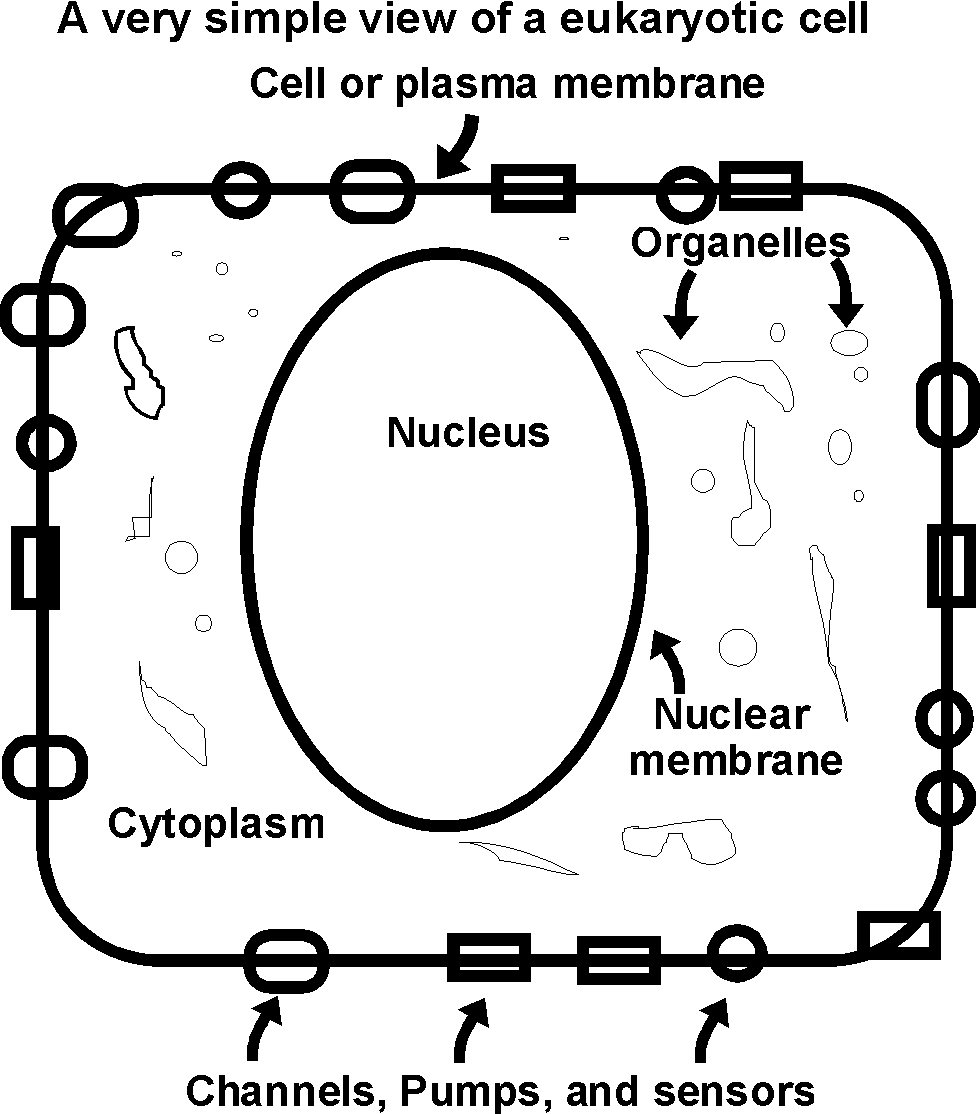
Click here for a better picture of a typical animal eukaryotic cell [Purves6ed 4.7a].
[See Ch. 5 of Savada to read more about cell structure if you want. Most intro bio courses include this material at this point]
The size of this skin cell is about 10 µm in diameter. (µm = µ = micron = one millionth of a meter)
[An an aside, consider some units of size here: 1 millimeter (mm) = 1/25 inch (easily visualized, ~pinhead size); 1 micron ("micrometer", µm = 1/1000 mm, approximate the limit of a light microscope; the human eye can resolve 100 µm (0.1 mm)].
Typical animal cells = ~10 µm in diameter
The smallest cells are ~ 1 µm (~ at the limit of the light microscope, [~ the wavelength of visible light])
[ Aside : pushing to smaller length units, a nanometer = nm = 1/1,000,000 of a mm, = the size (diameter) of small molecules:
e.g., water (~0.5 nm), the alcohol ethanol (~1 nm), the sugar glucose (~1.5 nm)
[a term less used but that you may run into: the Angstrom (A)= 1/10 nm = distance between two atoms in a molecule (e.g., 2 A)]
The smallest cells are ~ 1 um. What about these smallest cells, the 1 micron cells? Smaller should be simpler yet, no? There'd be less room for much stuff. This is true. The smallest cells are those of bacteria:
They are 1-2 µm in cross-section, so they are about 1/1000 the size of our 10 µm skin cell (comparing a cube of 1 um dimensions vs. a cube of 10 um dimensions).
They have a more complicated surface (there is a hard cell wall outside the plasma membrane, to protect them, and sometimes 2 cell membranes.).
But there is no true nucleus, and much less complicated machinery inside, no big organelles. Indeed, bacteria are about the size of many animal or plant cell organelles (e.g., a mitochondrion). While eukaryotic cells have a nucleus (the name means that), bacteria do not and are called prokaryotes. Click here for a better picture of a prokaryotic cell [Purves6ed 4.3].)
 The simplest living things are made up of a single cell.
The simplest living things are made up of a single cell.
A second big simplification (besides size): the skin cell was one of trillions that made up the organism. For most bacteria, the number of cells in the organism is: ..... one.
That is, most bacteria are unicellular organisms.
Before we go any further considering bacteria, the simplest of all living things, let's see how they fit into a classification of all other living things according to these 2 criteria so far raised: simplicity and unicellularity.
Examples:
| Some examples | Unicellular | Multicellular |
| Prokaryotes: no true bounded nucleus present |
(Mostly= bacteria): Pneumococcus (disease) Rhizobium (plant symbiosis) Escherichia coli (lab) |
Very few examples |
|
Eukaryotes: the nucleus is a separate membrane-bound compartment |
Amoebae (ponds, disease) Paramecium (ponds) Plasmodium (malaria) Yeast (beer, bread, lab) |
Human being Worm (C. elegans) Fruit fly (Drosophila) Zebra fish Mustard plant (Arabidopsis) Mouse (these examples also represent popular model organisms for research) |
Click here for a view of a simplified evolutionary classification of all living things [Purves6ed 1.8]
The simplest cell
is a bacterial cell.
So the simplest living things are
cells and the simplest cells appear to be bacteria. To discuss and discover most
fundamental life processes, we will focus on bacteria, just as researchers did
during the development of modern biology from 1950 to 1980.
Study of the basic
characteristics of life in simple bacterial cells has facilitated understanding
in biology.
But there are millions of species
of bacteria. How to choose ... Consider E. coli = Escherichia coli: found
(by Dr. Escher) to inhabit the colon of most mammals, including people. So E.
coli are readily available. They are in general non-pathogenic (most strains).
They grow fast and in a very simple growth medium (just sugar and salts) in the
laboratory. And some major advances in understanding genetics happened to be
made by researchers studying this particular organism, starting in the 1940's.
Biologists wanting to extend these initial findings did not want to complicate
matters by using a different organism, so many took up E. coli as their
experimental material, and so the use of this organism snowballed.

E. coli grow by binary fission. First the cell grows larger, and then when it has attained a size about double that at its smallest size, it divides into 2 cells.
Their doubling time in a simple growth medium is about 1 hour.

What are cells made of?
The
atoms used to make a bacterial cell must be assimilated from the environment.
Here is an example of a
simple, minimal, medium (the unique essential elements provided by each compound
are underlined):
C6H12O6
glucose, a sugar: KH2PO4 potassium phosphate MgSO4 magnesium sulfate NH4Cl ammonium chloride H2O water +trace elements (e.g., Zn, Fe, Cu, Se, … ) |
Notice there is only one organic (= carbon (C)-containing) compound in this medium (glucose). The remaining substances are inorganic salts, providing the elements potassium, phosphorous, magnesium, sulfur, nitrogen, hydrogen and oxygen. There are also a few more metal elements needed in very small amounts
E. coli can be
made from glucose
All the carbon atoms in E. coli's 5000 types of molecules can be
derived from this one molecule
Each E. coli cell contains about
10,000,000 total organic molecules, representing thousands of distinct chemical
structures. So that simple diagram of binary fission means, at the least, that
for one E. coli to become two E. coli, it must synthesize about 10,000,000
molecules of ~ 5000 different kinds, in just an hour, starting with just
one kind of organic molecule (i.e., glucose, C6H12O6).
We will be considering how E. coli, and some other kinds of cells, do exactly this (that is, reproduce), over the next 2 months.
I found myself explaining some of this to my father-in-law once; he had seen a diagram of the glucose molecule on my computer screen and asked what it was. I explained that it was glucose, and, with this lecture in mind, that glucose was just about all you needed to make an E. coli cell. Figuring me for a biotechnologist, and expecting ever-greater things from biology from his reading of the Tuesday Times, he said, "Are you serious? You mean you can synthesize a living E. coli cell in the laboratory from glucose? How do you do it?" When I explained: "Well, you need to start with one E. coli cell to get the second one …", his face dropped. "Oh. Okay, but that's cheating," was his reaction.
He was taking life, cell growth, for granted, because it was so familiar: growing children get taller and taller, the grass has to be mowed twice a week in May, mold the size of a quarter appears on an old peach overnight. No, we can't put together a brand new E. coli cell in a test tube; that would be a truly impressive feat. But is it really any less impressive that E. coli can do it, without a test tube? In one hour, take 10 million glucose molecules and transform them into 5000 different things, all organized to fit together in a cell that can do it all over again, in one more hour. How? How do these little cells know what to do, know how to do it, and how do they actually carry it out? If, like my father-in-law, you're not really curious about the answer, then you're probably in the wrong course.
Cell
reproduction: How one gets
two cells from one is a central problem posed in this course.
So let's get started on this 2-month explanation.
We can break the problem down into several parts, which will give you a preview of where we're headed:
To understand the
question, we first must know just what molecules a cell is made of .
1. What is an E. coli cell, chemically speaking (What
is it made of, what do we have to make more of?)
A quick answer: polysaccharides, proteins, lipids, nucleic acids, and
small molecules.
That is, the
5 categories of E. coli's molecules are: Polysaccharides,
Lipids, Nucleic
Acids, Proteins, Small molecules
2. How do we get those
chemicals?
Answer: From glucose, via biosynthetic chemical reactions (=
metabolism).
3. Where does the energy for
this process come from?
Answer: from glucose, via energy metabolism.
(so glucose has a 2nd role, not just providing carbon atoms)
4. Where does E. coli get the information for
doing all this?
Answer: it's hard-wired in its DNA.
-------------------------------------------------------------------------
Before we get down to business with question #1 (the chemical definition of the cell), let's consider some mathematical consequences of this reproduction by binary fission, or bacterial cell growth.
Exponential growth: But first, how do cells grow, in a
quantitative view?
For example, suppose we want to
measure the amount of nitrogen in a healthy viable bacterial cell. Typically,
for this type of a chemical analysis, we will need several billion of these tiny
cells. That's part of the simplicity of working with a unicellular organism.
Since all the cells are the same, any property you measure (e.g., nitrogen
content, or say, DNA content), represents a value that's true for each cell. - -
That's not necessarily true if you were studying a multicellular organism, like
broccoli, which is made up of many different tissues (florets, stems, roots, leaves),
with each of these tissues containing many different cell types.
Binary fission
leads to exponential growth.
Say we start with one cell, put it
in minimal medium, where it and its daughter cells will grow and divide once
very every hour:
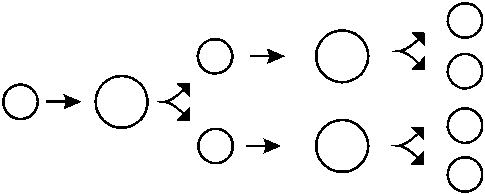
1 cell --> 2 cells in 60 min., or 1 generation; 60 min. = Doubling time = tD
How can we calculate the time it will take to get a billion cells, so we know when to come back to the lab to collect these cells for analysis?
Let g = number of generations. From the binary fission mechanism: after 2 gens. --> 4 cells, after 3 gens. --> 8 cells, etc.
So we can see that the number of cells at any given point, N = 1 x 2g (starting with one cell).
If we started with one million cells, then N = 106 x 2g
More generally, starting with No cells: N = No x 2g
Since we want to know what time to come back, it is more convenient to express generations in terms of time. If we let tD = the generation time, or doubling time, then the number of generations that have passed during the time interval t is just t/tD. So generations, g = t/tD.
So now N = No x 2t/tD, an equation that expresses exponential growth (with respect to time)
Or, more generally and simpler to write: N = No x 2kt , where k=1/tD, is a constant for a given cell type under a defined condition (i.e., growth medium and temperature).
Exponential growth is
mathematically predictable.
This exponential growth equation can be expressed in many interrelated
equivalent forms, many of which are useful:
N = No ekt, where k = ke = ln2/tD, and, writing it another way: ln(N/No) = ket
and: N = No10kt, where k = k10 = log2/tD, and: log(N/No) = k10t
Note here that the growth constant k is being defined differently for the different numerical bases used to express the exponential nature of the growth.
The derivation of these forms is described in the exponential growth handout.
[Below in italics was not in the live lecture by intention, since it is more easily followed at your leisure here]
Now to return to a problem we set for ourselves, of how long it would take for one E. coli cell to grow into 1 billion cells. We could solve this equation for t, since we know we want N to be 1 billion, No is 1, and tD is 1 hr. Taking the logarithm base 2 of both sides of the base 2 equation N/No=2t/tD:
we get log2 (N/No) = t/tD, then, solving for t, we get t = tD [log2(N/No)]
And plugging in the numbers we have: t = log2 (1,000,000,000/1) = log2(109) hours (since the doubling time was in hour units)
But say your calculator does log base 10 but not log base 2. No problem, convert log base 2 to log base 10 (log) or to the natural log, base e (ln).
log2 of any number X = lneX/lne2 = lneX/0.69 = more simply: lnX/0.69 (since "ln" with no other indicator means log base e)
or, log2X = log10X/log102 = logX / 0.3 (since "log" with no other indicator means log base 10)
Applying this last one (base 10) to our problem, and since you now know that the log2 = 0.3 from the line above:
t = log2(109) = log(109) /0.3 = 9/0.3 = 30. So it would take 30 hours for one cell to become one billion.
Related exponential transformations are: 2x = 10xlog2 and 2x = exln2,
And useful numbers are: log(2) = 0.30, ln(2) = 0.69
To continue our transmogrification of these exponential growth equations:
log2(N/No) = t/tD
So log2(N/No) = log(N/No)/log2 = t/tD
log(N/No) = (log2/tD)t = Kt, where K = log2/tD = 0.3/tD and so log(N/No) = (0.3/tD)t
or, converting back to the exponential form:
N = No10Kt, where K=0.3/tD as mentioned before.
Since most scientific calculators have natural log functions, similarly, we can write
N = NoeKt, where this K = ln2/tD = 0.69/tD , which is the usual form of the exponential growth equation
---------------------------------------------------
Let's have one more look at the exponential growth equation:
We could also have approached this question of rates of change of N with time more directly and naturally using calculus. If you have a million cells, then after one generation time you will have gained 1 million. If you had 200, then you would have gained 200. In general, the rate of increase of N with time is just proportional to the number of cells you have at any moment in time, or:
dN/dt = kN
Separating variables: dN/N = kdt
Integrating between time zero when N = No and time t, when N = N, we get:
lnN - ln No = kt - 0, or ln(N/No) = kt, or N/No = ekt, or
N = Noekt, which is exactly what we derived above.
We can now calculate this constant k by considering the time interval over which No has doubled; in that case N/No = 2 and t = tD, so 2 = ektD. Taking the natural logarithm of both sides:
ln2=ktD, or k=ln2/tD, so the constant comes out exactly as before as well.
This is probably the last time you will see calculus in this course, so don't be scared off by thoughts of complex math.
You will need mostly arithmetic, some algebra, and an ability to work with exponential notation and an occasional logarithm.
There are several problems of this type in the problem book, solving for N, for t, for No, etc.; be sure to do them.
Finally, let's look at the growth of a
bacterial culture graphically.
If we plot N vs. t :
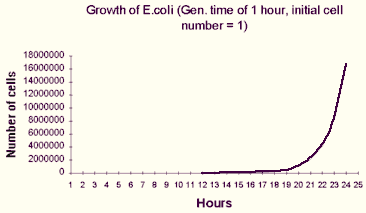
But ln(N) vs. t should give a straight line (a semi-log plot):

In reality, a growth curve for a bacterial culture looks more like this:
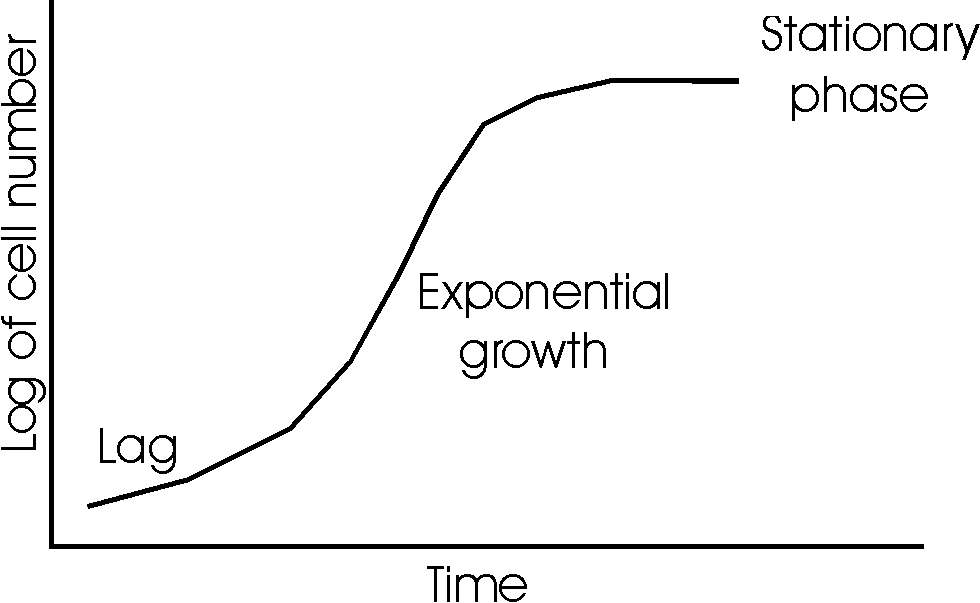
Note the 3 phases: a lag (while the cells are getting geared up), log (logarithmic) phase or exponential phase (linear on a semi-log plot such as this), and finally stationary phase (after the nutrients have been exhausted and/or toxic excreted products have built up as the culture becomes dense).
So we can treat cell reproduction quantitatively, and that's what growth looks like mathematically.
We now start on the problem of how the bacterium E. coli reproduces, how it grows; how we get two E. coli cells from one.
It is this story that will make up much of this course. We will start with the simple and move to the more complex (as opposed to the opposite, also a valid approach). We will start with description and then move to process and function at each step.
First we need to know what are the chemicals that need to be made if we are to create one net E. coli cell. We need to turn to the nature of the chemicals that make up an E. coli cell, so we know what it is that we need to make in an hour.
(Water:
Most
abundant single molecule)
Let's start with the most abundant and most important molecule in the cell, not
an organic molecule, but water, H2O. We
will use our discussion of the water molecule as a springboard for introducing
different types of chemical bonds that are important in biology.
A more accurate representation than H20 would be: HOH, showing that each hydrogen atom is bonded to the oxygen atom.
Or H-O-H, where the dashes indicate covalent bonds, the sharing of electrons.
Or, showing the actual angle formed by the 2 bonds to H:
 ,
,
or, showing the sharing of electrons more explicitly:
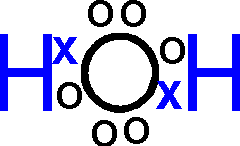 .
.
Covalent bonds are very strong bonds. We can compare the strength of various chemical bonds by noting the amount of energy it would take to break the bond. For most covalent bonds this is about 100 kilocalories per mole (kcal/mole), where calories are a unit of energy (1 cal = energy needed to raise 1 gram water 1 degree C; Calorie in dieting (with an uppercase C) = kilocalorie (kcal)).
A yet more accurate portrayal would be:
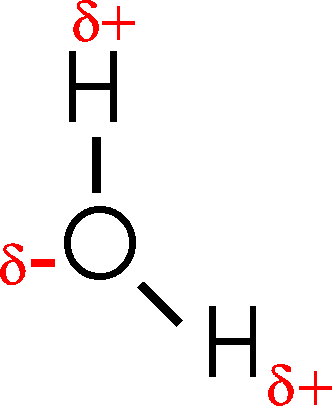
This configuration [Purves6ed 2.8] has important consequences, because although the electrons are indeed shared between the H's and the O, they are not shared equally. The oxygen nucleus is more electronegative than the hydrogen nucleus, that is, it attracts the shared electrons more strongly than the hydrogen nuclei. As a result, the O is slightly negatively charged and the H's are slightly positively charged.
The
![]() 's indicate a
partial charge, as opposed to a full charge. You'd get a full charge if the electron were
to be completely captured by one of the partners, resulting in the formation of
charged ions, as chlorine atom does in table salt (NaCl --> Na+ and
Cl-).
's indicate a
partial charge, as opposed to a full charge. You'd get a full charge if the electron were
to be completely captured by one of the partners, resulting in the formation of
charged ions, as chlorine atom does in table salt (NaCl --> Na+ and
Cl-).
So water is a polar molecule (one with a charge separation, one side is slightly negative and the other slightly positive), and this property has profound consequences for biological molecules.
Water forms
hydrogen bonds
As a result of this polarity, each
water molecule can be attracted to another water molecule, depending on the
orientation. This attraction is very sensitive to orientation, being sharply
maximal when the O - H - O atoms are lined up:
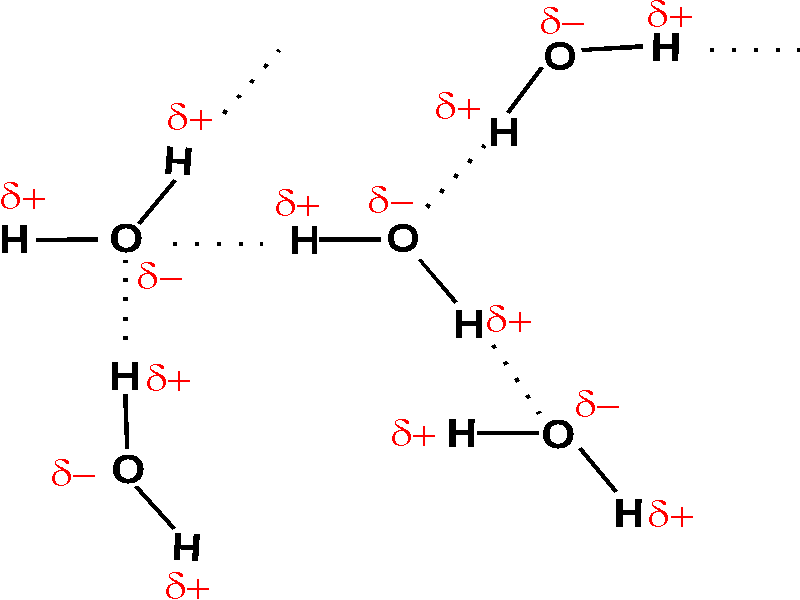
These connections between two molecules are called hydrogen bonds. Their strength is about 3 kcal/mole, thus they are weak bonds compared to the strong covalent bonds of ~100 kcal/mole. To chemically break covalent bonds by the thermal motion induced by heat, you would typically need hundreds of degrees (e.g., breaking oxygen-oxygen bonds when burning coal). In contrast, hydrogen bonds are readily disrupted at temperatures between freezing and boiling (0o - 100oC). In fact, freezing and boiling of water is a reflection of the hydrogen bonding: Gas = so much thermal motion that no hydrogen bonding is possible [Purves6ed 2-15c]; liquid = H-bonds are constantly forming, breaking, and re-forming [Purves6ed 2-16b]; solid = hydrogen bonds are locked in a stable crystal structure, which is ice [Purves6ed 2.16a].
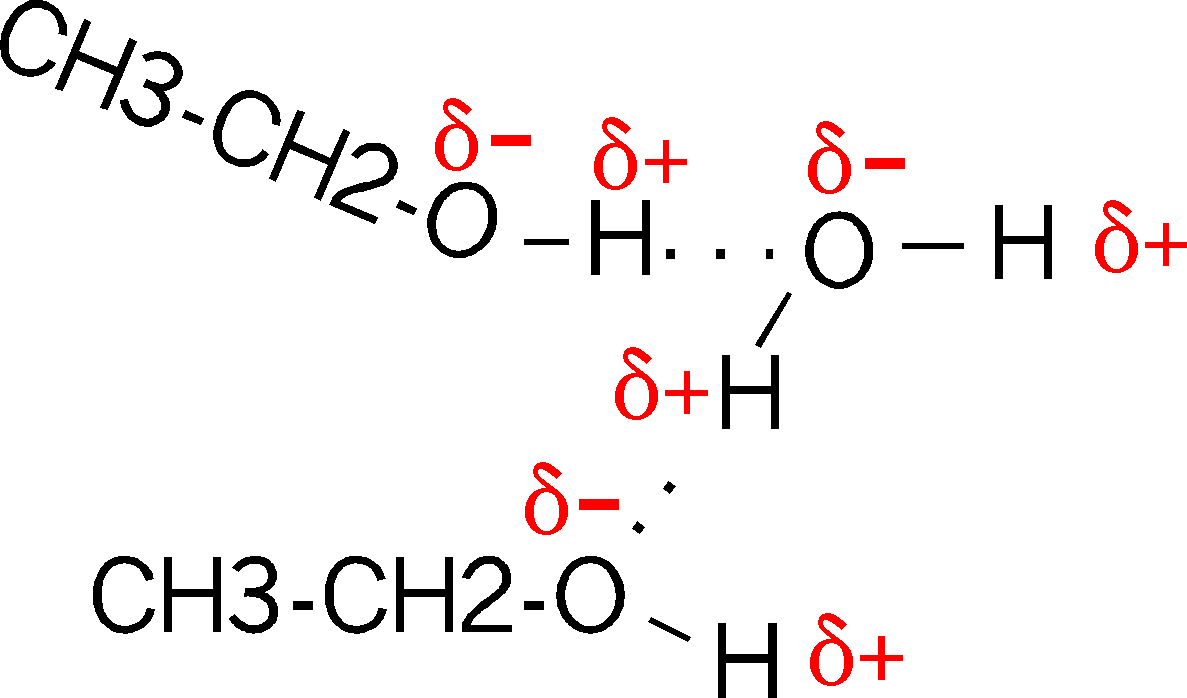
Are there H-bonds in compounds other than water? Sure. Consider ethanol (alcohol), which has an hydroxyl group (-OH, see functional groups handout; we will be discussing almost all of these functional groups at one time or other). Compare CH3-CH2-OH, vs. ethane (CH3-CH3) which does not have this polar hydroxyl group. The hydroxyl group is polar, for the same reason as in water. So it can H-bond to water when it is in an aqueous solution (as most biological molecules are). It is for this reason that most compounds with polar groups are very soluble in water. That is, they are constantly forming these weak bonds to the water molecules.
Note that carbon always forms 4 bonds.
And the H-bonds are not limited to oxygen in O-H groups: nitrogen is also more electronegative than hydrogen, as in an amide (-CO-NH2), and oxygen is more electronegative than carbon (as in the C=O part in the same amide):
("R" is shorthand for any general organic group, one that is not necessarily relevant for the discussion at hand.)
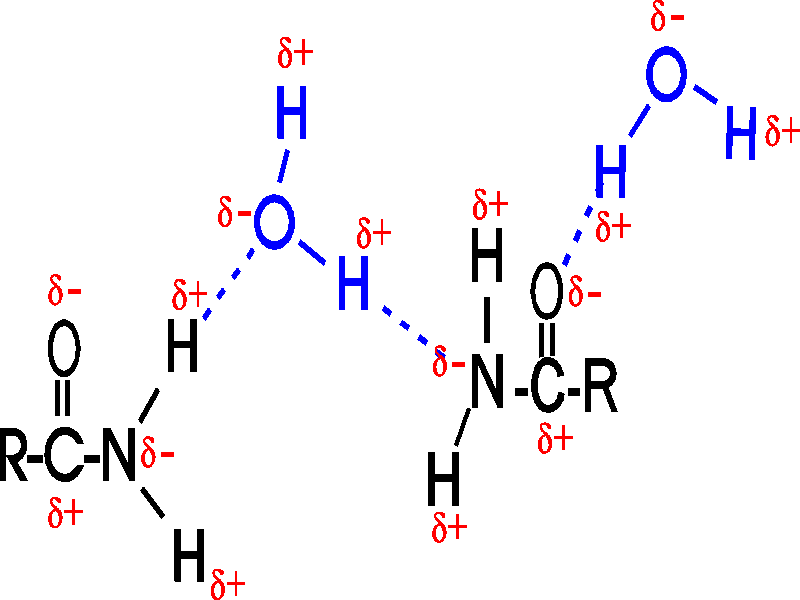
 How about H-bonds between organic molecules?
Sure, if they can find each other: e.g., ethanol-acetamide, and the orientation
is important here, as with water. (If the amide in the diagram were acetamide,
the R would be -CH3)
[Purves6ed 2.9].
How about H-bonds between organic molecules?
Sure, if they can find each other: e.g., ethanol-acetamide, and the orientation
is important here, as with water. (If the amide in the diagram were acetamide,
the R would be -CH3)
[Purves6ed 2.9].
In aqueous solutions such interactions will always be competing with water molecules, which are usually more abundant (not always true, however, as we will see)....
(Next: Water molecular structure used as a springboard to discuss all weak bonds:)
NOTE: The functional groups used in this course must be memorized. See the Functional Groups handout. This is one of very few memorizations required.
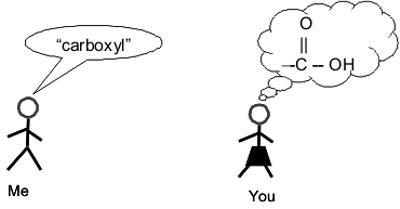
C) Copyright 2010 Lawrence Chasin and Deborah Mowshowitz Department of Biological Sciences Columbia University New York, NY 10027